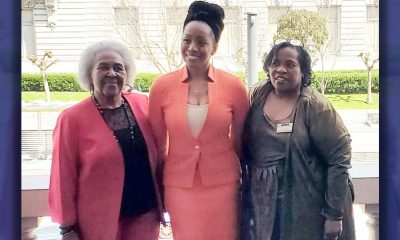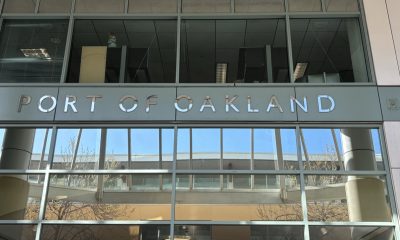Bay Area
Mayor London Breed Announces Plan to Reform City’s Small Sites Housing Acquisition Program
“Our Small Sites program is an important part of our overall strategy to make housing affordable to all San Franciscans,” said Mayor Breed. “Preserving rent-controlled housing helps keep people in their homes, protects against displacement and evictions, and creates more stability in our neighborhoods as we make crucial decisions to build more housing in all neighborhoods. We are committed to working with our non-profit partners to reform and strengthen this program so we can make impactful investments in our upcoming budget and support the long-term viability of the Small Sites program.”

Improvements made in partnership with non-profits that help administer the program will ensure long-term success of important housing preservation and anti-displacement program
Mayor London N. Breed and Supervisors Myrna Melgar and Ahsha Safaí announced on Tuesday the next steps to strengthen and reform San Francisco’s Small Sites Program, which preserves rent-controlled buildings and prevents tenant displacement.
First launched in 2014, the City has helped acquire 47 buildings (368 units of affordable housing) through the Small Sites Program.
The Small Sites Program is run by the Mayor’s Office of Housing and Community Development (MOHCD), which works to acquire and preserve at-risk rental housing with three to 25 units.
The program was created to establish long-term affordable housing in smaller properties throughout San Francisco that are particularly vulnerable to market pressure that results in property sales, increased evictions, and rising tenant rents.
In the face of the increasing pressure, the Small Sites Program helps San Franciscans avoid displacement or eviction by providing loans to non-profit organizations to successfully remove these sites from the market and restrict them as permanently affordable housing.
While the program has been an important tool, challenges have impacted implementation and acquisition. Mayor Breed sat down with non-profit partners who work with the City on administering the program and agreed to a plan to reform over the coming months to ensure the long-term viability of the Small Sites Program. Those commitments include:
- Undergoing a study on how to make the program more efficient and the model more applicable. This study will be conducted by the Housing Accelerator Fund (HAF), which partners with the City on housing preservation and acquisition efforts. HAF’s recommendations are due in January.
- Considering reform recommendations from the City’s housing partners.
- Implementing programmatic reforms by the end of March 2022.
- Supporting capacity in the City’s non-profit partners to make small sites deals and ensure that the buildings are financially sustainable.
- Modernizing and reforming programming rules to ensure broader applicability geographically, including in neighborhoods currently left out of the program because of income limitations.
- Ensuring that vacant units are immediately filled.
“Our Small Sites program is an important part of our overall strategy to make housing affordable to all San Franciscans,” said Mayor Breed. “Preserving rent-controlled housing helps keep people in their homes, protects against displacement and evictions, and creates more stability in our neighborhoods as we make crucial decisions to build more housing in all neighborhoods. We are committed to working with our non-profit partners to reform and strengthen this program so we can make impactful investments in our upcoming budget and support the long-term viability of the Small Sites program.”
“San Francisco’s vitality is dependent on keeping our current residents stably housed. The Small Sites Acquisition Program has so much untapped potential to save our diminishing rent-controlled housing stock and to keep our communities intact. We need to be bold and shift the way we have been doing things to meet this moment. Our City’s economic recovery is dependent on investing in the residents and businesses that are struggling to stay here,” stated Supervisor Myrna Melgar.
“The Small Sites program preserves existing affordable units for working families here in San Francisco through acquisition,” said Supervisor Ahsha Safaí. “Together with Mayor Breed and Supervisor Melgar’s leadership – we have renewed our support for this vital program and San Francisco’s middle-income families. We are committed to working with our local non-profit partners and I’m proud to help lead this process to increase affordable housing options for San Francisco’s working families.”
“We thank the Mayor for renewing her commitment to the City’s housing acquisition and affordable preservation program,” said Malcolm Yeung, executive director of the Chinatown Community Development Center. “While this has been a critical tool in preventing displacement of our most vulnerable residents, it has not always worked as planned. Not only do we have to expand accessibility to a broader range of San Franciscans, especially our lowest income, we have to make the program sustainable for the organizations that are doing the work of acquiring, rehabbing, and operating the housing.”
“MEDA is firmly committed to the proven, targeted approach of the City’s Small Sites Program to fight displacement. Since 2014, our nonprofit has made 33 critical acquisitions, keeping in their longtime homes hundreds of families and dozens of commercial businesses,” said MEDA CEO Luis Granados. “Our Community Real Estate team has been maintaining and growing the program throughout the pandemic, building our own capacity and that of our nonprofit peers so that we are all best positioned to continue to purchase Small Sites apartment buildings. In partnership with the City, we look forward to acquiring additional critical buildings as we further strengthen the program to ensure all properties are financially stable and that every unit becomes home to those most in need of affordable housing.”
Activism
Oakland Post: Week of April 24 – 30, 2024
The printed Weekly Edition of the Oakland Post: Week of April 24 – 30, 2024
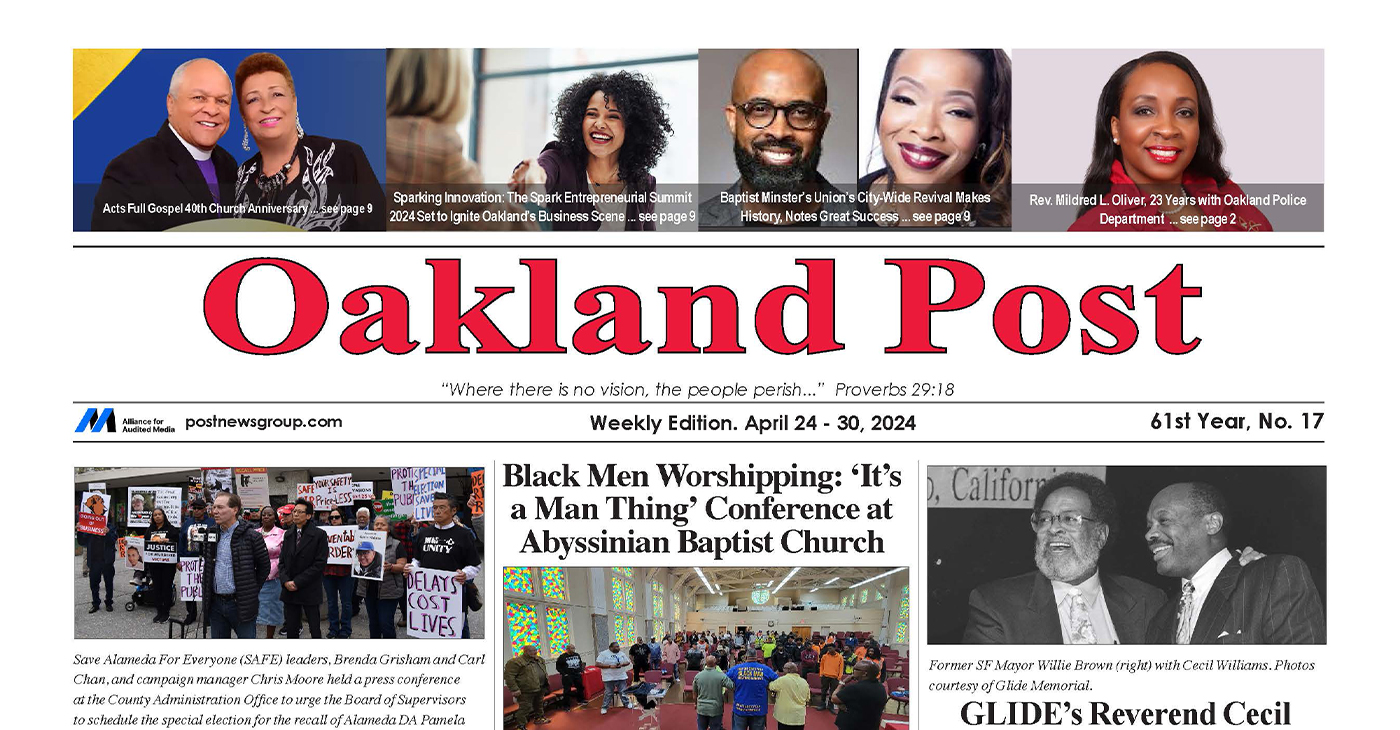
To enlarge your view of this issue, use the slider, magnifying glass icon or full page icon in the lower right corner of the browser window. ![]()
Alameda County
DA Pamela Price Stands by Mom Who Lost Son to Gun Violence in Oakland
Last week, The Post published a photo showing Alameda County District Attorney Pamela Price with Carol Jones, whose son, Patrick DeMarco Scott, was gunned down by an unknown assailant in 2018.
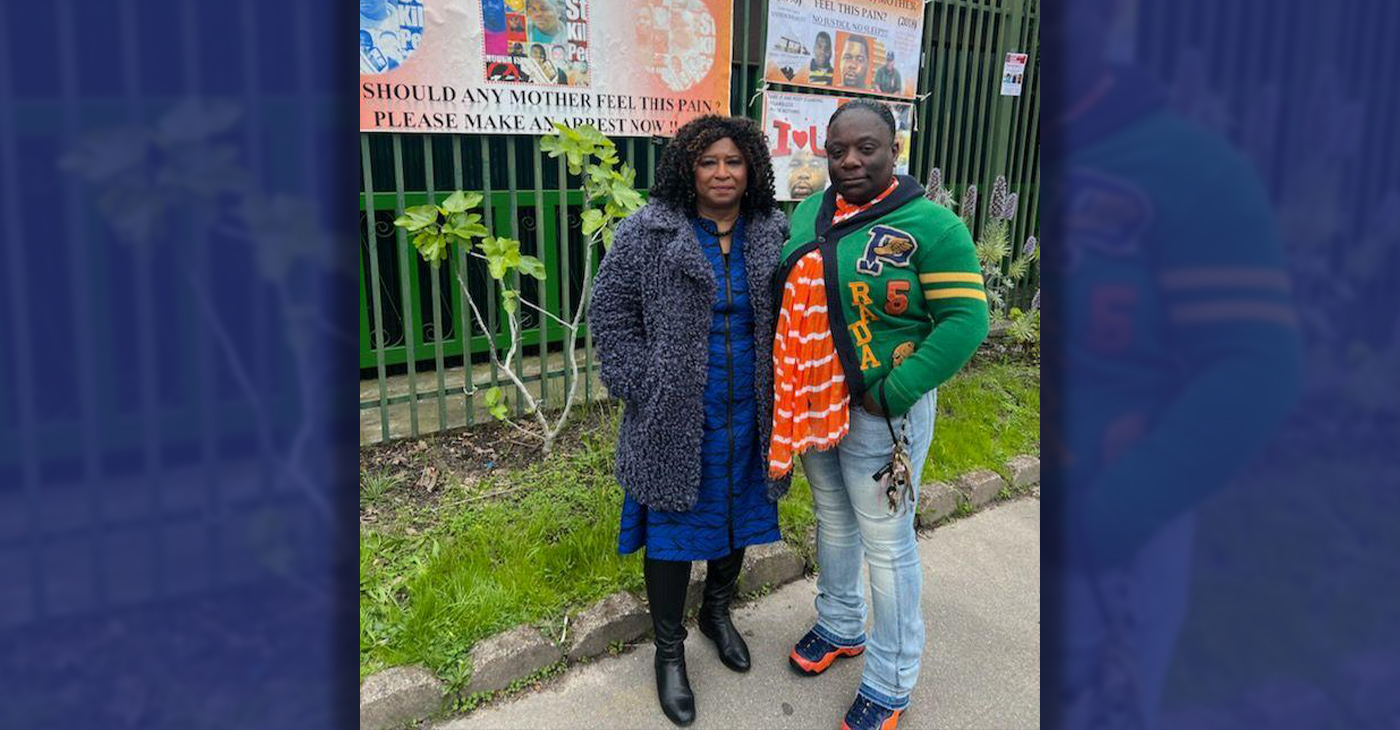
Publisher’s note: Last week, The Post published a photo showing Alameda County District Attorney Pamela Price with Carol Jones, whose son, Patrick DeMarco Scott, was gunned down by an unknown assailant in 2018. The photo was too small for readers to see where the women were and what they were doing. Here we show Price and Jones as they complete a walk in memory of Scott. For more information and to contribute, please contact Carol Jones at 510-978-5517 at morefoundation.help@gmail.com. Courtesy photo.
Bay Area
State Controller Malia Cohen Keynote Speaker at S.F. Wealth Conference
California State Controller Malia Cohen delivered the keynote speech to over 50 business women at the Black Wealth Brunch held on March 28 at the War Memorial and Performing Arts Center at 301 Van Ness Ave. in San Francisco. The Enterprising Women Networking SF Chapter of the American Business Women’s Association (ABWA) hosted the Green Room event to launch its platform designed to close the racial wealth gap in Black and Brown communities.
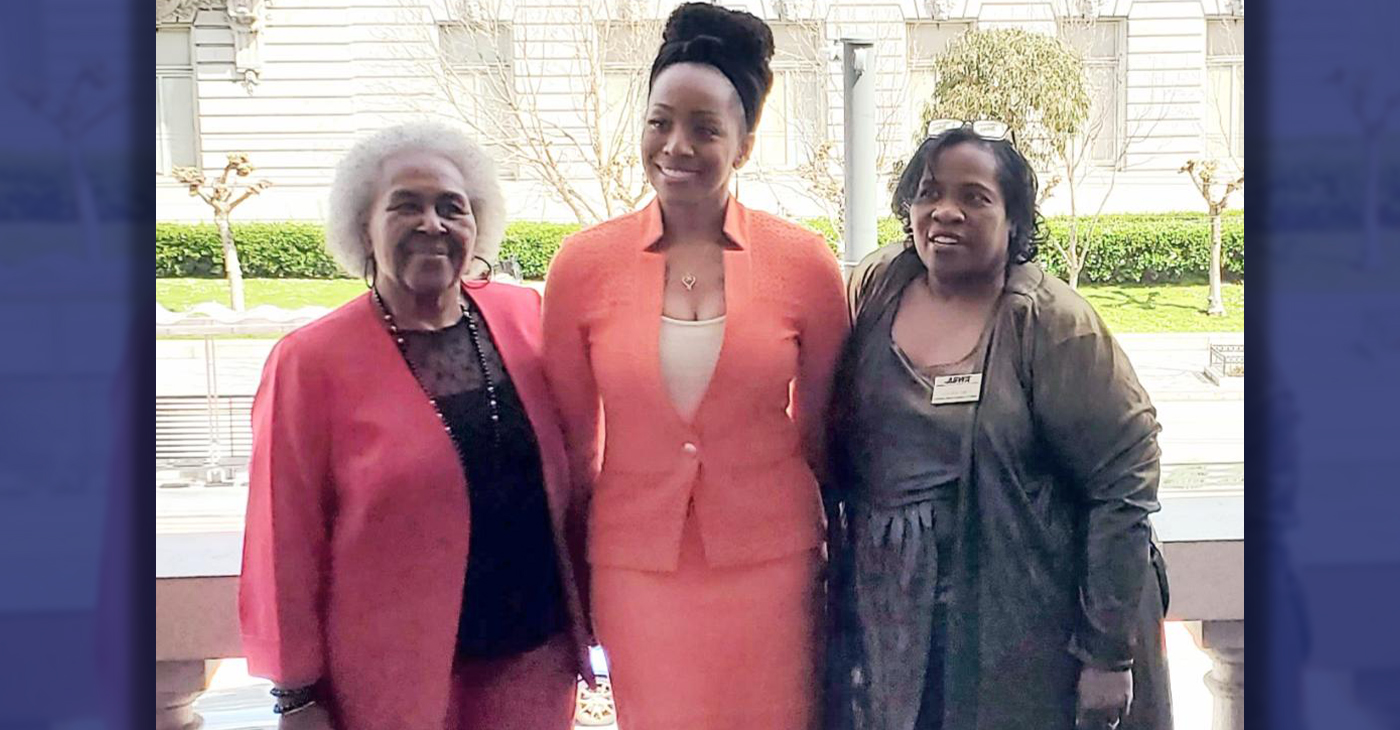
By Carla Thomas
California State Controller Malia Cohen delivered the keynote speech to over 50 business women at the Black Wealth Brunch held on March 28 at the War Memorial and Performing Arts Center at 301 Van Ness Ave. in San Francisco.
The Enterprising Women Networking SF Chapter of the American Business Women’s Association (ABWA) hosted the Green Room event to launch its platform designed to close the racial wealth gap in Black and Brown communities.
“Our goal is to educate Black and Brown families in the masses about financial wellness, wealth building, and how to protect and preserve wealth,” said ABWA San Francisco Chapter President LaRonda Smith.
ABWA’s mission is to bring together businesswomen of diverse occupations and provide opportunities for them to help themselves and others grow personally and professionally through leadership, education, networking support, and national recognition.
“This day is about recognizing influential women, hearing from an accomplished woman as our keynote speaker and allowing women to come together as powerful people,” said ABWA SF Chapter Vice President Velma Landers.
More than 60 attendees dined on the culinary delights of Chef Sharon Lee of The Spot catering, which included a full soul food brunch of skewered shrimp, chicken, blackened salmon, and mac and cheese.
Cohen discussed the many economic disparities women and people of color face. From pay equity to financial literacy, Cohen shared not only statistics, but was excited about a new solution in motion which entailed partnering with Californians for Financial Education.
“I want everyone to reach their full potential,” she said. “Just a few weeks ago in Sacramento, I partnered with an organization, Californians for Financial Education.
“We gathered 990 signatures and submitted it to the [California] Secretary of State to get an initiative on the ballot that guarantees personal finance courses for every public school kid in the state of California.
“Every California student deserves an equal opportunity to learn about filing taxes, interest rates, budgets, and understanding the impact of credit scores. The way we begin to do that is to teach it,” Cohen said.
By equipping students with information, Cohen hopes to close the financial wealth gap, and give everyone an opportunity to reach their full financial potential. “They have to first be equipped with the information and education is the key. Then all we need are opportunities to step into spaces and places of power.”
Cohen went on to share that in her own upbringing, she was not guided on financial principles that could jump start her finances. “Communities of color don’t have the same information and I don’t know about you, but I did not grow up listening to my parents discussing their assets, their investments, and diversifying their portfolio. This is the kind of nomenclature and language we are trying to introduce to our future generations so we can pivot from a life of poverty so we can pivot away and never return to poverty.”
Cohen urged audience members to pass the initiative on the November 2024 ballot.
“When we come together as women, uplift women, and support women, we all win. By networking and learning together, we can continue to build generational wealth,” said Landers. “Passing a powerful initiative will ensure the next generation of California students will be empowered to make more informed financial decisions, decisions that will last them a lifetime.”
-

 Activism4 weeks ago
Activism4 weeks agoOakland Post: Week of March 27 – April 2, 2024
-

 #NNPA BlackPress4 weeks ago
#NNPA BlackPress4 weeks agoBeloved Actor and Activist Louis Cameron Gossett Jr. Dies at 87
-
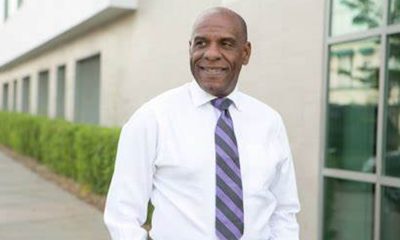
 Community1 week ago
Community1 week agoFinancial Assistance Bill for Descendants of Enslaved Persons to Help Them Purchase, Own, or Maintain a Home
-
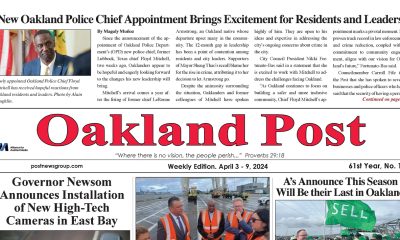
 Activism3 weeks ago
Activism3 weeks agoOakland Post: Week of April 3 – 6, 2024
-

 Business1 week ago
Business1 week agoV.P. Kamala Harris: Americans With Criminal Records Will Soon Be Eligible for SBA Loans
-
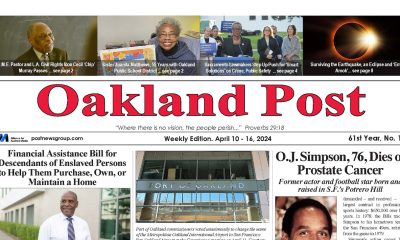
 Activism2 weeks ago
Activism2 weeks agoOakland Post: Week of April 10 – 16, 2024
-
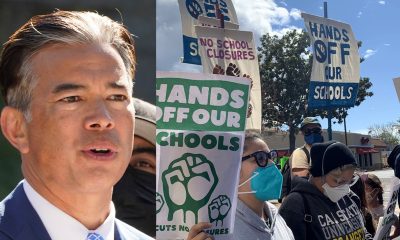
 Community1 week ago
Community1 week agoAG Bonta Says Oakland School Leaders Should Comply with State Laws to Avoid ‘Disparate Harm’ When Closing or Merging Schools
-

 Community6 days ago
Community6 days agoOakland WNBA Player to be Inducted Into Hall of Fame

